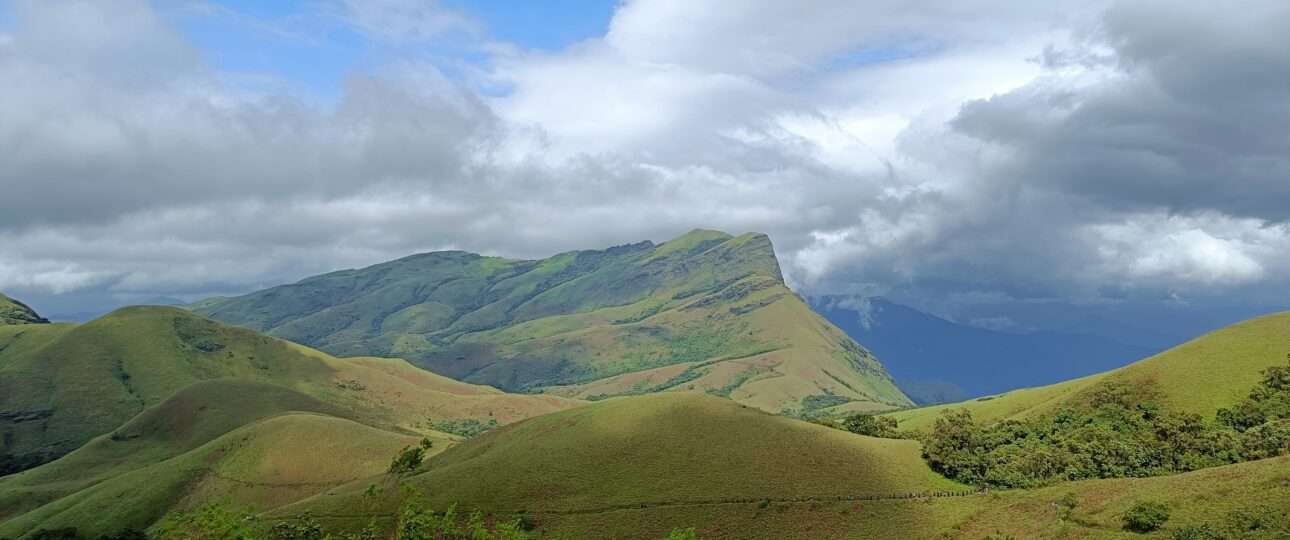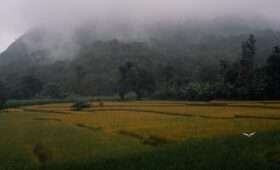In Kannada, Kudremukh translates as “horse’s face.” The peak’s unusual form is what gave it this name. Historically, this was also known as Samseparvath since Samse village used to be the entrance point. In the district of Chikkamagaluru, Kudremukh sits tucked away amid the western ghats. The second-largest wildlife protected area in the west of ghats, Kudremukh National Park, includes it. The third tallest mountain in Karnataka after Baba Budangiri and Mullayyangiri, it is located at a height of about 1.89 km (6,207 ft).
Numerous plants and animals may be found at Kudremukh. While walking, you can also see deer and peacocks along the path in addition to other animals! It is a lovely hike through the foggy valleys and rolling green hills. You go through forests, pastures, and several little streams.
The splendour of Kudremukh Trek is enhanced during and after the monsoon, when the vista from the peak resembles nothing less than a carpet of lush green trees. Also known as the “little Scotland of India,” Kudremukh.It is a great hiking location to travel to from Bangalore, making it the best destination for weekend getaways. These rolling hills’ lush vegetation draws attention thanks to their natural meadows and thick Shola woods.
The best time to travel to Karnataka for the Kudremukh Trek is during the summer, from March to May. The closest station is Mangalore Railway Station, where hikers may arrange for a cab or bus.
A distinctive feature on the Kudremukh summit resembles the side profile of a horse. After an hour of hiking from the forest office, you can see this building. Although it appears to be getting closer, there are still around 3 hours of hiking needed to get there.
Exploring Shola Forest
The grasslands and shrublands that are discernible in the western ghats are referred to locally as “shola.” Reaching the Kudremukh summit requires a hike through a shola forest. Deer, lion-tailed macaques, Malabar giant squirrels, leopards, common langurs, and a host of other animals call this forest home. They may be spotted when hiking if you’re lucky. Leeches may be found in every step in this region during monsoon season.
The little streams and waterfalls that may be seen in this area are among its most intriguing features. While ascending to the top, you must cross a lot of streams. You might occasionally need to cross while wearing damp shoes.
Rolling Hills
A breathtaking vista of the surrounding rolling hills greets you as you emerge from the shola forest. The eye is rewarded by verdant slopes and hazy valleys. During the monsoon, this region may be entirely enveloped in mist. But you shouldn’t pass up the opportunity to play hide-and-seek in the valley between those clouds and mist.
For authorization, come to the forest office as soon as you can. Starting from the forest office, the walk begins. Before you enter the woodland route, you can still hear the sound of the water pouring at Somawathi Falls. Watch how the greenery thickens as you reach the Shola forest. If you’re lucky, you might see some animals here. Numerous leeches and earthworms live in this woodland.
Things to do near Kudremukh
Kudremukh Trek
The journey starts in the village of Mullodi. The Western Ghats may be seen in some of its most stunning detail from the short 9 km (one way) trip up to an elevation of 1,894 km above sea level. You may witness the Western Ghats’ natural splendour, as well as a variety of streams and waterfalls and fragrant coffee farms, all in one location. Along with the Kudremukh peak, the Hanuman Gundi Falls, which are found on the ascent to the highest peak, are the main attractions. Hanuman Gundi Falls is a stunning waterfall of Kudremukh that may be seen in the rugged Western Ghats.
Kudremukh National Park
The beautiful splendour of Kudremukh National Park is well known. There are many things to do at the park, from high rising peaks covered in a wide variety of flora and wildlife to scenic trekking trails overlooking lush grasslands. The second-largest wildlife protected area in the Western Ghats region is part of a tropical wet evergreen forest. Many rare and indigenous plant and animal species may be found in the area, where tigers, leopards, and wild dogs are the main predators. Providing you with the best of the Western Ghats in spectacular detail, and its verdant surrounds are a nature and wildlife enthusiast’s heaven.
Hanuman Gundi Falls
Hanumana Gundi Falls is a multi-tiered waterfall with natural rocks as its landing area is close to Kudremukh National Park. It is situated in a peaceful area surrounded by forested hills and abundant greenery. To get to the bottom of the waterfall, you must descend 300 stone stairs. There develops a little, shallow pool. Locals often refer to Hanumana Gundi Falls as Suthanabbi Falls. Additionally, adventure seekers like it a lot. You might have had a relaxing dip in the pool earlier. Today, however, you must stand 100 ft above the lake to observe the water dropping. Almost little has changed in the area. Not a lot of people come here. So, Hanuman Gundi Falls, which is close to Kudremukh, are a great place for those who enjoy the outdoors. You may take a relaxing vacation amidst the natural world there. In the woodlands, you may have a wonderful day.
Kalasa
In the Chikkamagaluru district of Karnataka is Kalasa, commonly referred to as the temple town. On the banks of the Bhadra River is the stunning city. It’s surrounded by rainforests and is ideal for a break in the great outdoors. This area relies on the River Bhadra for water since it has a predominantly agricultural economy. The name is accurate since the greatest coffee and other plants are grown in Kalasa, a region blessed with fertile soil. Sri Kalaseshwara Temple, a shrine to Lord Shiva, is located in Kalasa. It is also recognized as a temple town in Karnataka that showcases the Southern Indian architectural legacy, which consists of a diversity of styles and design philosophies that reflect the rich culture of the region.



